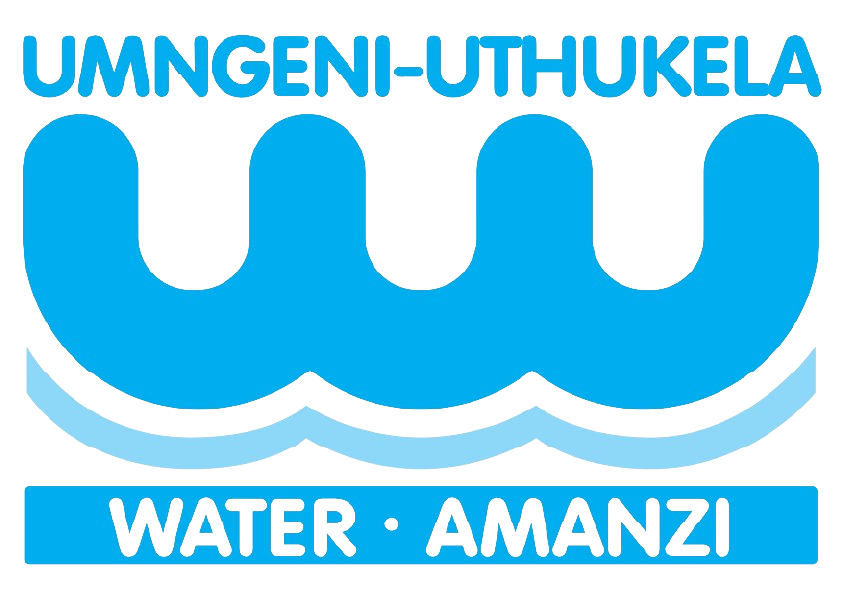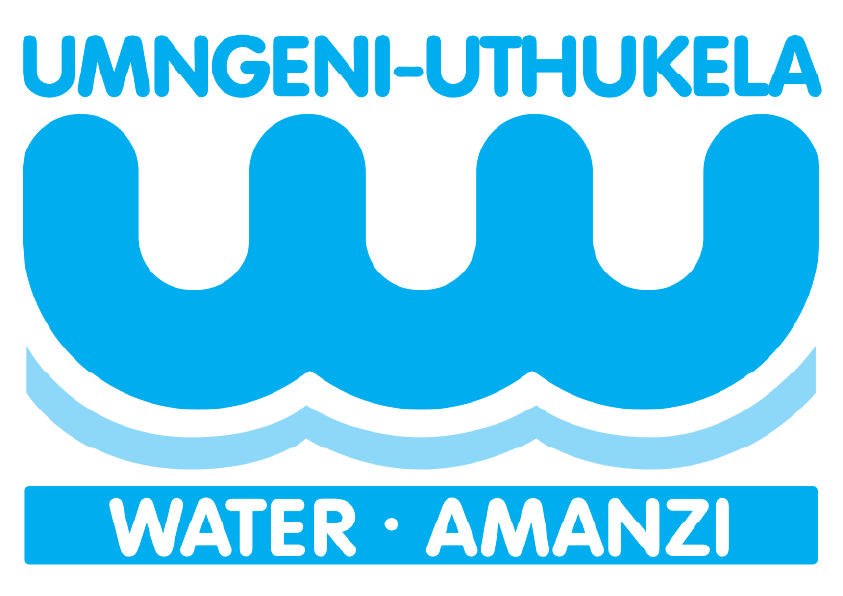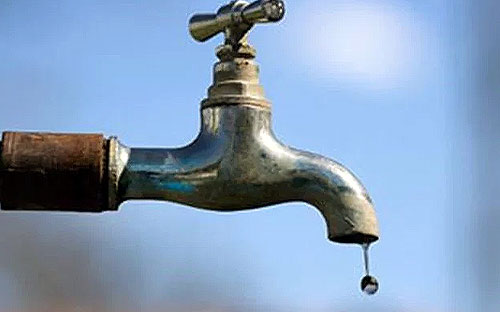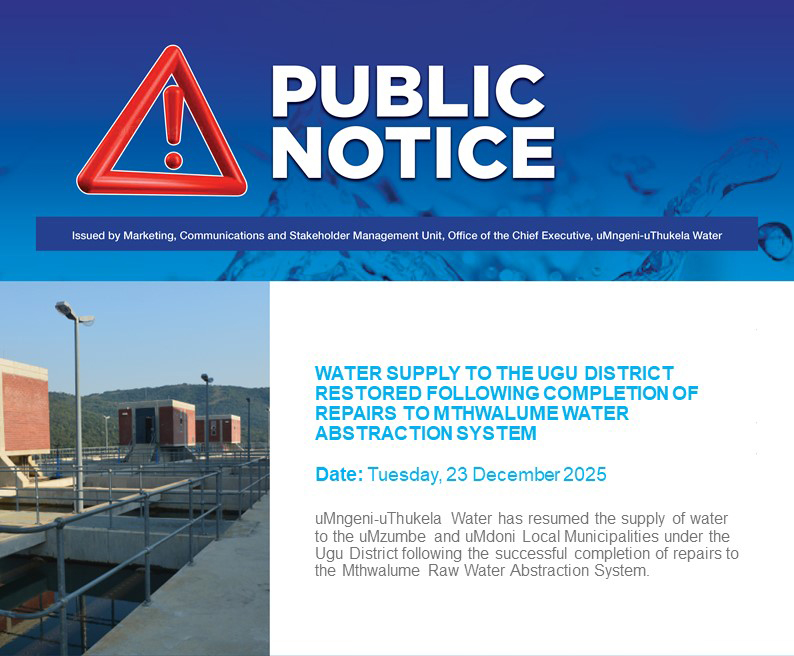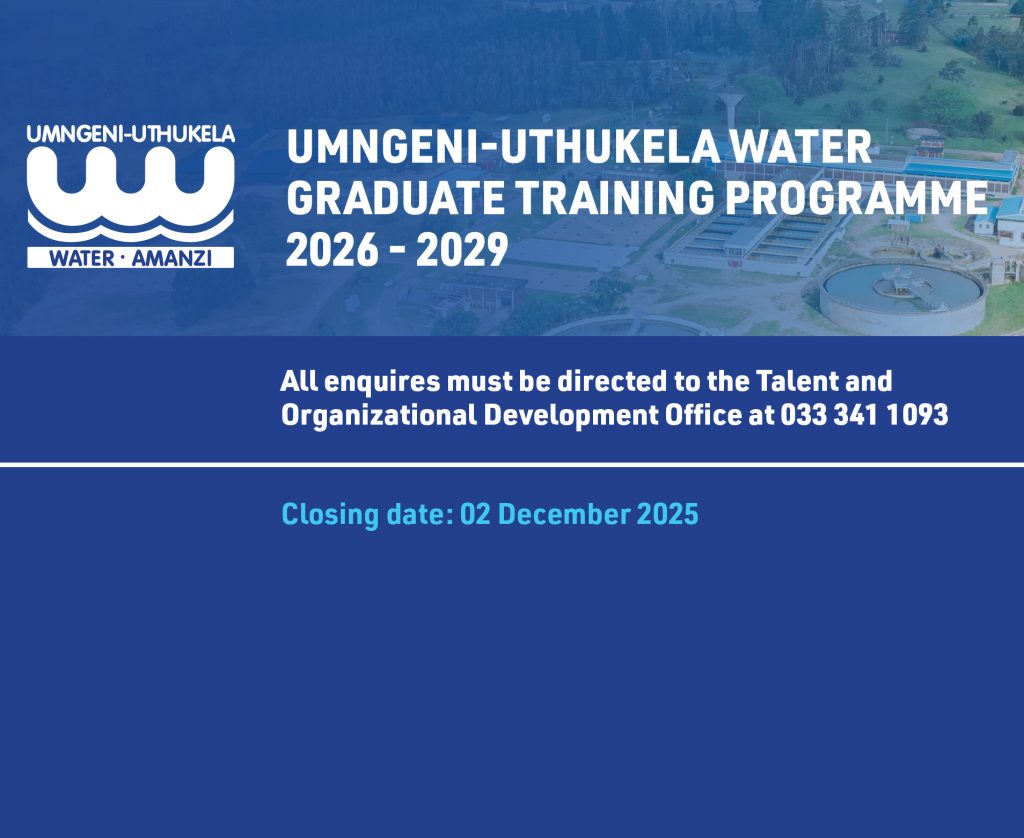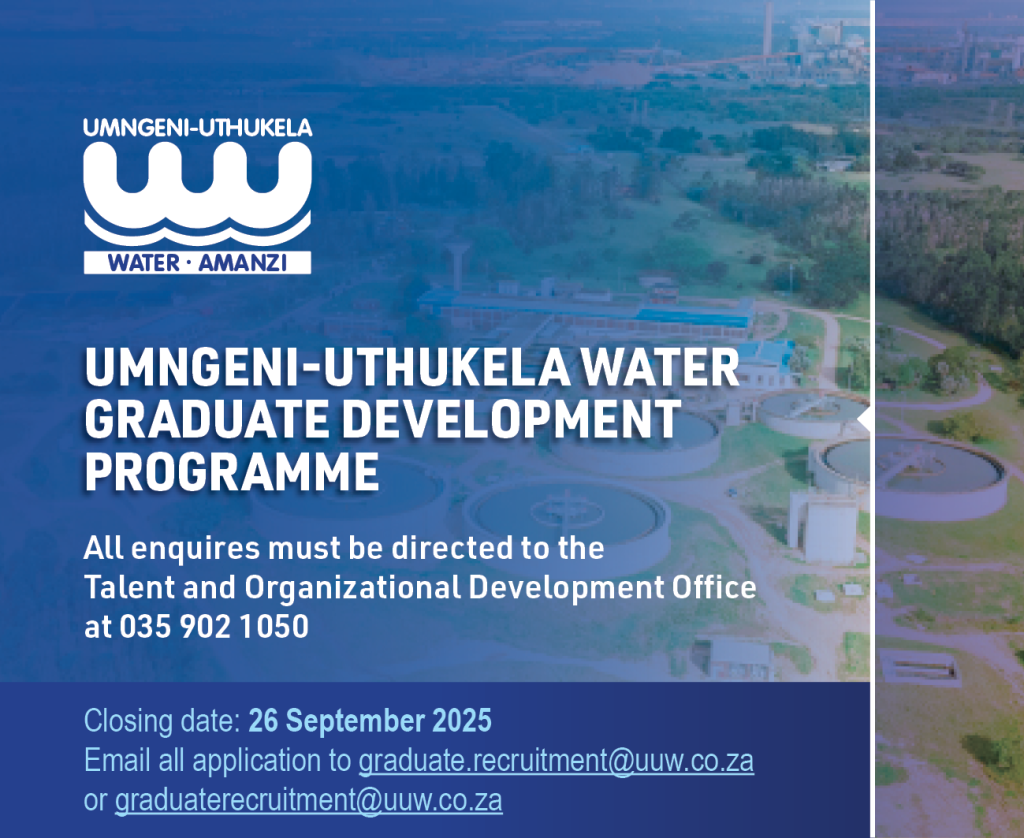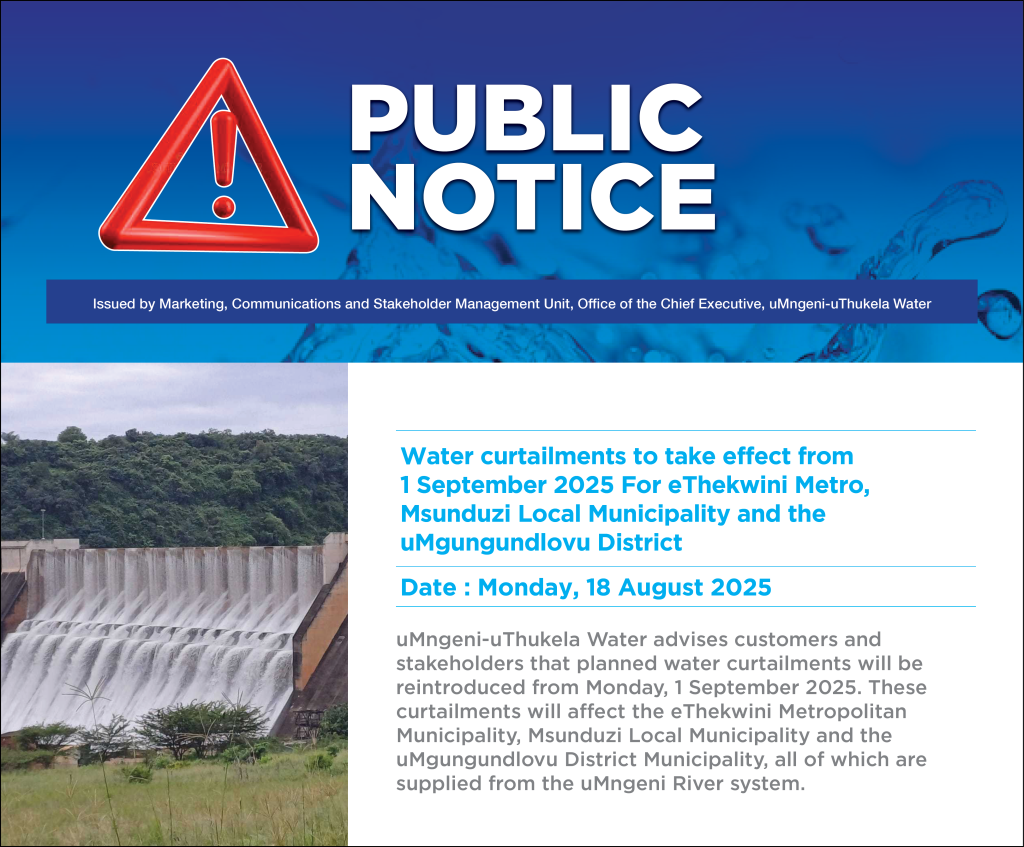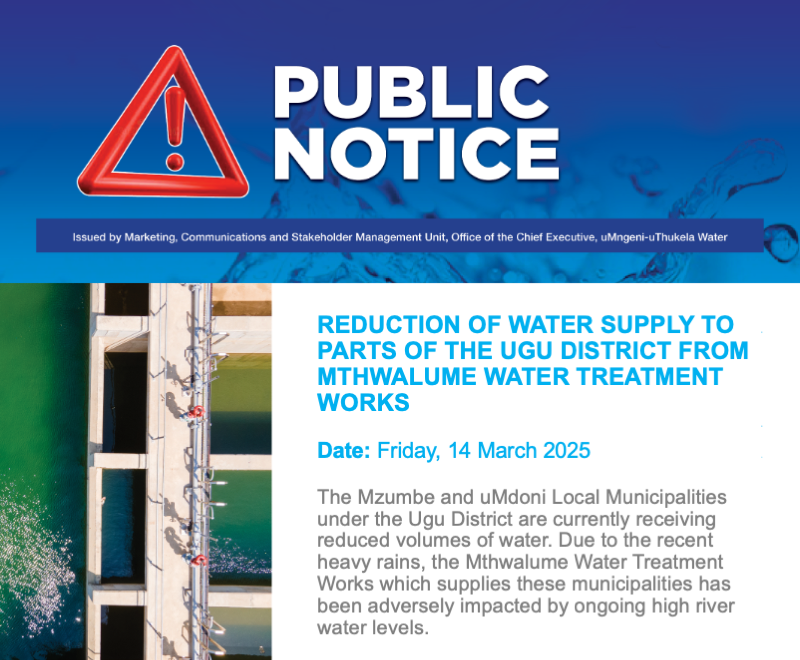[vc_row][vc_column][vc_column_text][/vc_column_text][/vc_column][/vc_row][vc_row][vc_column][vc_column_text]
Monday, 17 April 2023
Eskom electricity load shedding is affecting supply of drinking water to municipalities within uMngeni-uThukela Water’s service area. As a consequence, thousands of consumers within the uMgungundlovu District Municipality, Msunduzi Local Municipality, iLembe District Municipality, Ugu District Municipality, Harry Gwala District Municipality, King Cetshwayo District Municipality and the eThekwini Metropolitan Municipality receive an erratic supply of drinking water or, at times, no water from their taps for the duration of load shedding and often longer as water supply infrastructure recover from the effects of power outages.
Stage 6 load shedding was implemented from January 2023, initially intermittently, and subsequently it became more frequent. From Wednesday, 12 April 2023, to the present, Stage 6 has continued, resulting in power supply interruptions twice a day for at least four hours on each occasion at some of uMngeni-uThukela Water’s plants where raw is treated to drinking water quality.
In the Mgeni System, the largest system in KwaZulu-Natal, the areas worst affected by water supply failures through power supply interruptions are Vulindlela, Mpophomeni and Hilton, all of which are high-lying and dependent on the Howick West Reservoir for potable water to be transferred through a system of pumping. Other areas that do not receive water during load shedding are KwaHaza, KwaChief and Mashingini. In Impendle, all areas are affected while in the Mpofana system, Bruntville is often starved of water supply when power supply disruptions occur.
The Midmar Pump Station and the Midmar Water Treatment Works are excluded from load shedding; hence conveyance of raw water and its treatment are not affected. When power outages occur, downstream Millfalls Reservoir is able to receive water from the Midmar Water Treatment Works and it, in turn, is able to transfer the water to the Howick West Reservoir.
The water remains in the Howick West Reservoir until power supply is restored. Consequently, the reservoirs of uMgungundlovu District Municipality and Msunduzi Local Municipality in Vulindlela are unable to supply water to consumers in the vast area of Vulindlela. Water is pumped from the Groenkloof Reservoir in Hilton to Vulindlela. Hilton is affected when power supply outages occur.
The reservoir in Richmond is also reliant on the Midmar Water Treatment Works supply zone. It is affected because water has to be pumped there as well. Areas within Richmond that are affected by no water supply are Ndaleni, Nhlazuka and Mbutshisweni. In the Mkhambathini area, Ukhalo is known to be unable to receive water.
When power supply is restored, it takes at least an hour for the supply mechanisms, both in the bulk and reticulation networks, to return to full functionality. In the meantime, what little storage remains in reservoirs begin emptying out and there is no accompanying replenishment. This leads to intermittent or no water supply to consumers.
From the Midmar Water Treatment Works water is gravity fed to the eThekwini Metro via Point M in Umlaas Road. The eThekwini Metro is, therefore, able to receive full supply during load shedding for distribution to various areas, including Mid-Illovo, Eston, Umbumbulu and Hillcrest.
The DV Harris Water Treatment Works, situated in the outskirts of Pietermaritzburg and part of the Mgeni System, continues to take the brunt of load shedding. In an unrelated occurrence, on Thursday, 13 April 2023, a mechanical problem occurred in a valve situated on the bulk potable water pipeline that carries drinking water from this plant, which required staff of uMngeni-uThukela Water to temporarily shut down the pipeline in order for repair work to be conducted.
In this period, uMngeni-uThukela Water was unable to supply drinking water from this plant. The problem was resolved by the following day and supply restored, however, water supply interruptions caused by load shedding persist.
The DV Harris Water Treatment Works has a stand-by generator, but its operation for at least eight hours each day has created a situation of heavy diesel consumption. The 3 000-litre diesel storage tank on site depletes rapidly, and sourcing and refilling of it takes a few days. This means that during load shedding and when the stand-by generator is not working, water cannot leave the plant.
The DV Harris Water Treatment Works currently supplies 58Ml/d (58 million litres) of water through the Msunduzi Belfort Pipeline. This pipeline feeds both the Claridge Reservoir (for the uMshwati area) and Belfort Reservoir (for parts of Pietermaritzburg, Table Mountain and uMshwathi). The split in supply is 20Ml/d to Claridge Reservoir and 38 Ml/d to Belfort Reservoir. The uMshwathi system is fed using the Mpolweni pump station to supply two uMngeni-uThukela Water reservoirs, Wartburg (8 million litres) and another (1.5 million litres), and uMgungundlovu District Municipality’s 1.5 million litre reservoir. Dalton and Cool Air are supplied from the Wartburg Reservoir through smaller reservoirs. A system of electricity-driven pumping is used to transfer water to these areas.
uMngeni-uThukela Water is concerned about the impact of load shedding on its ability to fulfil its mandate to provide an interrupted supply of drinking water. Eskom and municipalities have been approached to consider providing dedicated power lines to each pump station. If this materialises, then the pump stations will not be affected when there is load shedding.
At the Maphephetheni Water Treatment Works in Inanda, a stand-by diesel-powered generator is used at times of power supply interruptions, thereby ensuring continuous supply of potable water. However, there has been a significant increase in diesel use and cost.
In the Durban Central Region, the Durban Heights Water Treatment Works has two incomers, one of which has been excluded from load shedding. The exemption includes all production units, shaft pumping and the KwaDabeka Pump Station. The section that has not been excluded affects feed to the Pinetown Pump Station, which means no pumping can occur.
The pump station at Inanda Dam has two sources of energy, namely a stand-by pump and Hillcrest and Mzinyathi that supply the eThekwini Metro electricity department. Inanda Dam is one of two sources of raw water supply to the Durban Heights Water Treatment Works, situated in Reservoir Hills, Durban. The other is Nagle Dam in Cato Ridge, from where water gravitates into channels and then into four aqueducts. This means that the Durban Heights Water Treatment Works has an assured supply of raw water from Inanda and Nagle dams and available power at all times to ensure the plant continues to produce potable water.
The Inanda Pump Station has been exempt from load shedding.
The Durban Heights Water Treatment Works supplies reservoirs in the north, south, central and inner west regions of Durban.
The interconnected Wiggins Water Treatment Works in Bonella, Durban, has been exempt from load shedding. This system supplies potable water to central Durban. It also augments the Amanzimtoti Water Treatment Works through a system of gravity feed and pumping. At times of load shedding, transfer of water from the Wiggins Water Treatment Works to the Amanzimtoti Water Treatment Works is interrupted, exacerbating the deficit that already exists at the Amanzimtoti Water Treatment Works.
Parts of the Middle South Coast served by uMngeni-uThukela Water, from Amanzimtoti in eThekwini to Umzinto in Ugu, remain constrained. Load shedding results in downtime of the South Coast augmentation booster pump station, which is situated between Wiggins and Amanzimtoti and is used to pump water to the Amanzimtoti Water Treatment Works. Supply to eThekwini Metro is from the Wiggins Water Treatment Works through a series of reservoirs and the South Coast augmentation booster pump station and is supported by the Amanzimtoti Water Treatment Works.
Reduced volumes of potable water caused by power outages at the booster pump station vary between 20% and 30% – or on average a deficit of between 30 Ml/d and 40Ml/d – depending on the stage of load shedding. Higher stages of power outages cause high levels of water shortages. This results in reduced supply to eThekwini Metro for reticulation to Amanzimtoti and similar reduction in supply to Ugu District Municipality.
The Umzinto Water Treatment Works loses approximately 30% in potable water production during load shedding periods. This is caused by reduced abstraction volumes of raw water from the Umzinto and EJ Smith dams because pumps are unable to work. When load shedding occurs, generators are used in what becomes a slow and long process that often produces yields less than required volumes. A similar situation prevails at the Mtwalume Water Treatment Works, which also experiences reduced volumes of potable water produced due to reduced volumes of raw water.
Mid-South Coast systems’ full recovery time post-load shedding is, on average, two hours.
The Mhlabatshane Water Treatment Works has a back-up generator, which allows it to operate when power is switched off by Eskom or if there is power failure due to problems in the network.
The cumulative effect is reduced sales revenue while costs are rising sharply through increased use of diesel.
The Lower uMkhomazi Bulk Water Supply Scheme, currently under construction in Cragieburn, Umkomaas, and 20km north west off Scottburgh, will in the near future alleviate water supply constraints in Amanzimtoti to Hibberdene through provision of 100Ml/d on a sustainable basis.
The Hazelmere Water Treatment Works in the north of Durban receives its water from the Hazelmere Dam through gravity feed. The water is treated at the plant and supplied to eThekwini Metro, iLembe District Municipality and Siza Water. This plant has been exempt from load shedding, therefore, it is able to supply all of the areas that receive water from it. There are five bulk distribution systems within the Hazelmere supply area: Ndwedwe; Verulam/Grange; La Mercy; Avondale and Waterloo. The only system that is affected adversely is Ndwedwe because generators used during power outages are only able to support 50% of capacity.
At Maphumulo, there are no generators at raw water abstraction points, therefore, the plant is unable to produce drinking water during periods of load shedding. The Lower Thukela Bulk Water Supply Scheme in Mandini is exempt from load shedding.
The water treatment plants in the King Cetshwayo District that are operated and managed by uMngeni-uThukela Water are affected during power supply outages because they do not have stand-by generators. This means the potable water that is produced cannot leave the plants and the Water Services Authority does not have adequate water to distribute to consumers in Eshowe and surrounding areas. The Ixopo Water Treatment Works, within Harry Gwala District Municipality, remains fully functional because it uses a diesel-powered generator at times of load shedding.
Issued by the Corporate Stakeholder Management Unit Office of the Chief Executive, uMngeni-uThukela Water
[/vc_column_text][vc_btn title=”Download Document” color=”primary” link=”url:https%3A%2F%2Fwww.umngeni-uthukela.co.za%2Fwp-content%2Fuploads%2F2023%2F04%2F17-04-2023-Load-Shedding-and-Impact-on-Water-Supply.pdf”][/vc_column][/vc_row][vc_row][vc_column][vc_column_text]
[/vc_column_text][/vc_column][/vc_row]
